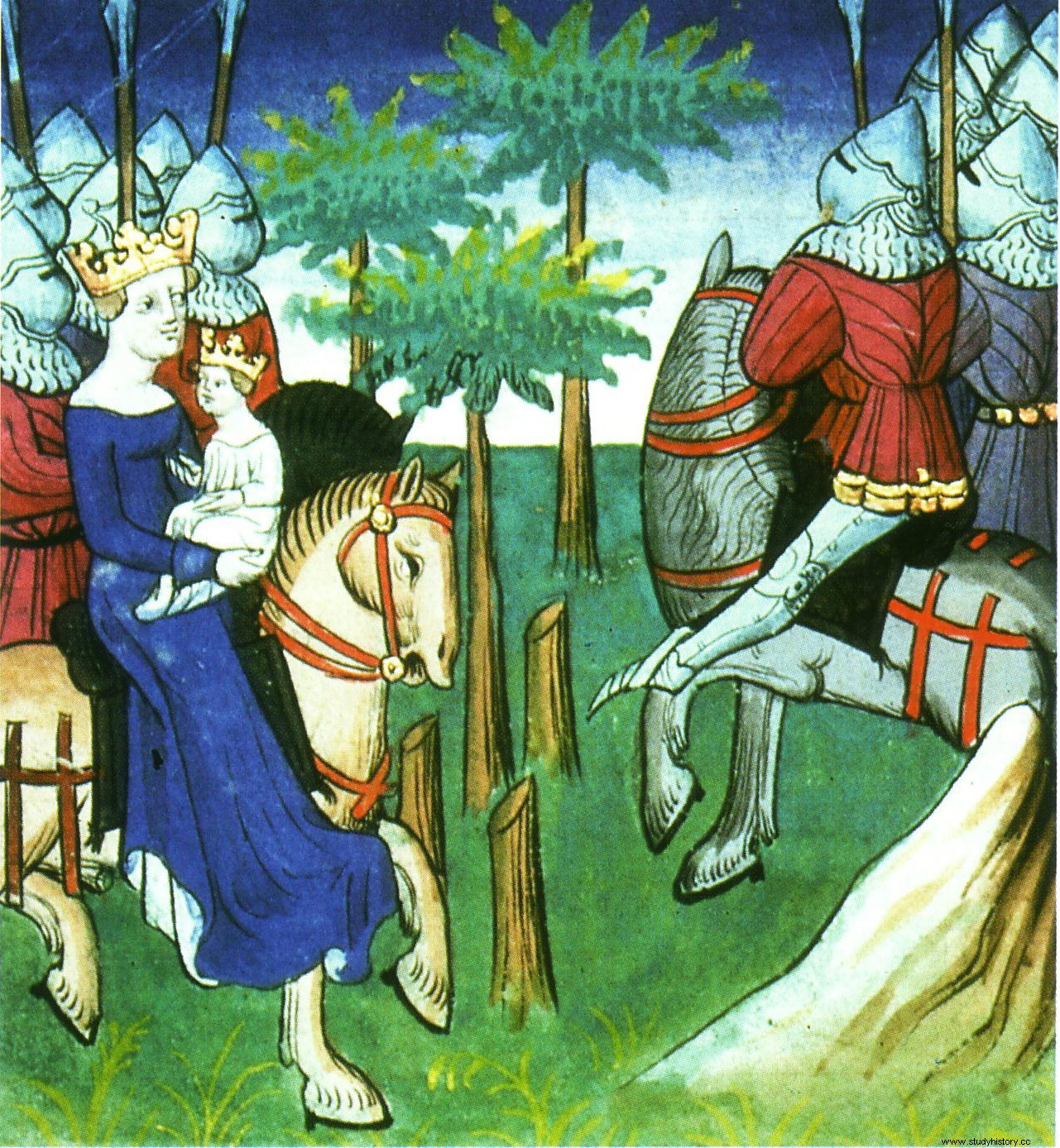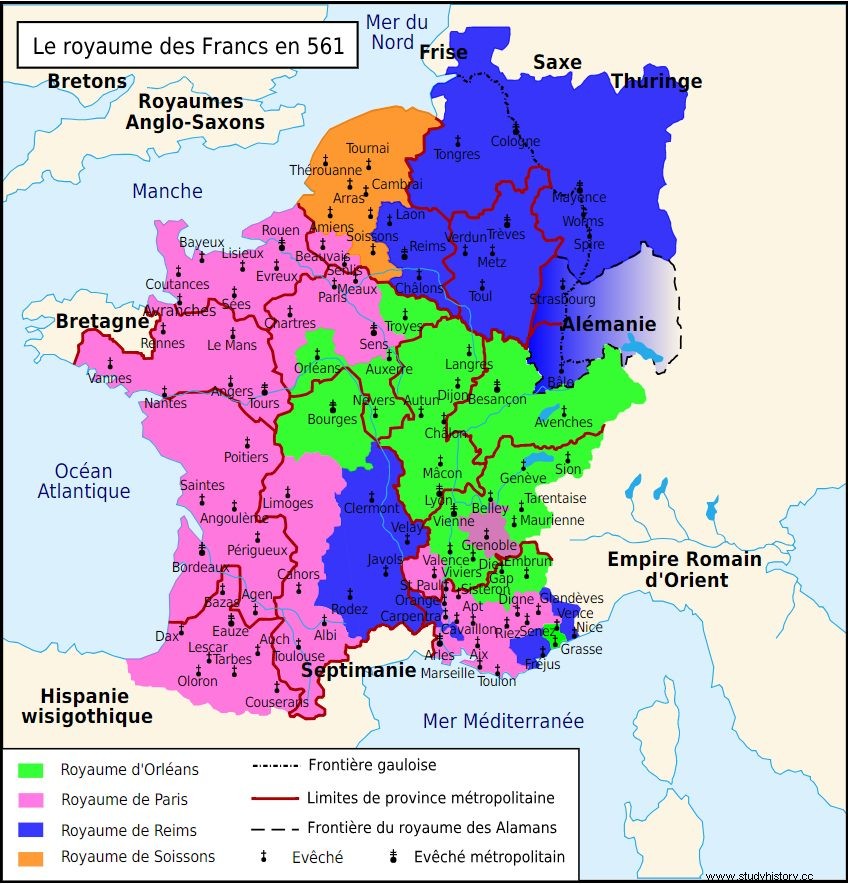Queen of Neustria, wife of King Chilperic I er , Frédégonde (circa 545 – 597) exercised power with her husband and then alone, and played a leading political role in her time. Ambitious, she is remembered as a cruel and power-hungry queen; she is particularly known for her rivalry with Queen Brunehaut.
[Warning:rapes]

The Frankish kingdoms
Frédégonde's date of birth is not known; of modest origin, she was born around 545, at the very beginning of the Middle Ages within the Frankish kingdom then governed by King Clotaire I st , son of the famous Clovis. She would have been born in Angicourt, in the Oise, within a family of serfs.
She was about fifteen years old when, in 561, King Clotaire I st died of pneumonia at the age of 60. As on the death of his father before him, the kingdom is left as an inheritance and divided between his four sons by lot.
 The eldest, Caribert, receives the kingdom located between the Somme and the Pyrenees, including the Paris basin. Chilpéric receives the kingdom of Soissons, in the north. Gontran receives the former kingdom of Burgondie. Finally, the youngest, Sigebert receives the kingdom of Reims. A few years later, the death of Caribert without a male heir caused a new division of the kingdom, bitterly disputed, between his brothers, and drew the borders of the Merovingian kingdoms:Austrasia, Neustria and Burgundy.
The eldest, Caribert, receives the kingdom located between the Somme and the Pyrenees, including the Paris basin. Chilpéric receives the kingdom of Soissons, in the north. Gontran receives the former kingdom of Burgondie. Finally, the youngest, Sigebert receives the kingdom of Reims. A few years later, the death of Caribert without a male heir caused a new division of the kingdom, bitterly disputed, between his brothers, and drew the borders of the Merovingian kingdoms:Austrasia, Neustria and Burgundy.
From following to queen
Frédégonde probably enters the service of Queen Audovère, wife of Chilpéric who reigns over Neustria, as next. Quickly, the king takes Frédégonde as his mistress. According to the Liber historiæ Francorum , a later anonymous source (8 e century), Fredegonda abuses the queen by convincing her to hold her fifth child, Childesinde, herself at the baptismal font; godmother of her own daughter, she would have been unable to share the marital bed, under penalty of incest. The hypothesis is not confirmed, but Audovère is repudiated.
Around 565, Chilpéric's brother, Sigebert, married the Visigoth princess of Hispania Brunehaut. The alliance threatens the possessions of Chilpéric and, to ensure the neutrality of the father of Brunehaut, the king marries the older sister of Brunehaut, Galswinthe. Dreading and refusing this marriage, the princess is forced to submit to it and to abjure her faith, the Arian religion.
The relationship between the two spouses deteriorated rapidly, especially as Chilpéric continued to frequent his mistresses and in particular Frégédonde. In 567, the father of Galswinthe and Brunehaut died, and the alliance lost all political interest in Chilpéric. He does not repudiate his wife, however, so as not to lose her dowry; a few months after her father's death, Galswinthe was murdered by a servant of her husband. After a few days of widowhood, Chilpéric marries Frédégonde.
The royal faide
The brutal murder of his sister scandalizes Brunhilda and aggravates the tensions born during the division of the kingdom. To find a solution, a court is set up and Gontran, the third brother, is made judge. Rather than dethroning Chilpéric, the King of Burgundy then decided that the cities received by Galswinthe as dower – the property of the husband reserved for the wife in the event of death – should revert to Brunehaut. Chilperic initially pretended to submit, but in 572 he sent his son Clovis to take the towns of Tours and Poitiers. Sigebert replies; it is the beginning of the royal faide (customary revenge), a war between Neustria and Austrasia which will last until 584.
After years of conflicts and alliances made and defeated, Sigebert led brilliant counter-attacks and Chilpéric was forced to retire to Tournai. Sigebert is recognized as king of Neustria by his own enemy's army but, in December 575, when he is about to be crowned, he is assassinated by pages of Queen Fredegonda.
This reversal of the situation places Chilpéric in a position of strength. He seized Paris, and imprisoned Queen Brunehaut who managed to shelter her five-year-old son Childebert II, heir to the throne. She would flee the following year, becoming regent to her infant son.
Political killings
Frédégonde gave birth to six children, many of whom died very young. His sons Samson, Dagobert, Chlodebert and Thierry, born between 575 and 582, all died before the age of five. The queen worked despite everything to ensure the succession to her descendants, and to get rid of the children of Chilpéric with Audovère. Thibert dies during the conflict; Mérovée is killed on the orders of his father; Clovis is assassinated, perhaps on the orders of Frédégonde; Basine, finally, is raped by men from Frédégonde to "dishonor" her and make her lose her rights to the inheritance. She will then be sent to an abbey.
In 584, Frédégonde gave birth to her sixth child, Clotaire. The same year, Chilpéric was assassinated on his return from a hunting trip. The murderer manages to escape and will not reveal his secrets:chroniclers evoke a murder ordered by Brunehaut, others accuse Frédégonde, who would have cheated on her husband. This death, however, places the queen, who is losing her support, in difficulty.
Gontran
The death of Chilpéric opens a period of disorder. The greats of the kingdom seized the king's treasures and important documents before taking refuge in Neustria, while Fredegonda's supporters abandoned him and the marriage of the queen's eldest daughter, Rigonde, with the Visigoth king of 'Hispania, is cancelled. Sporadic conflicts break out between cities.
To protect the heir to the throne, Frédégonde asks her brother-in-law Gontran, whose four sons died in infancy, to adopt her; Brunehaut, for his part, demanded that the King of Burgundy deliver Frédégonde to him in retaliation for the murder of Sigebert, which he refused. An assembly of the Grands of Neustria recognizes Frédégonde's child as Chilpéric's heir, and Gontran agrees to adopt him. The King of Burgundy then becomes regent for his nephew and adopted son. Order gradually returned, and Frédégonde was sent to the diocese of Rouen, under the supervision of Bishop Prétextat.
Fredegonde's return to power
Quickly, Frédégonde tries to escape the custody of the man of the Church, who does not relax his surveillance. On Easter Day 586, Prétextat was assassinated in full mass in front of the altar by a serf who would have been paid by Frédégonde and political rivals. Free again, the queen struggles to regain her influence and forge alliances for herself and her son. In response, Gontran sought to ally the aristocracy of Neustria. Relations between the queen and the king soured, and Gontran became closer to Brunehaut and his son Childebert II. He concludes a pact with them making the two kings the heir of the other. This agreement made Childebert II, on the death of Gontran in 592, the king of Austrasia and Burgundy – and Brunehaut the de facto ruler.
The conflict between Neustria, led by Frédégonde, and Austrasia and Burgundy under Childebert II, continues. Little by little, the Queen of Neustria entrusts her young son with an initially symbolic role, of representation. In 593, when he was only nine years old, he appeared at the head of the armies fighting against a duke of Austrasia. In 597, Frédégonde, aged about 52, died and left her son to reign alone.
